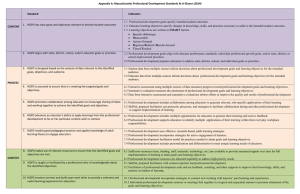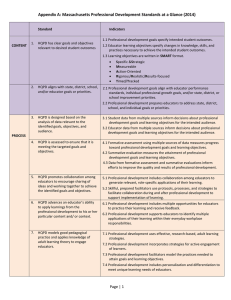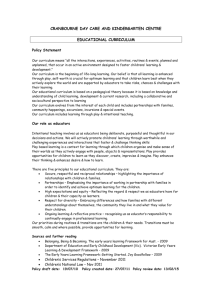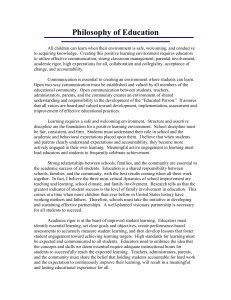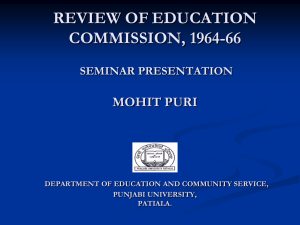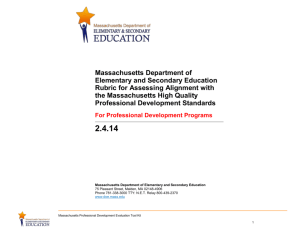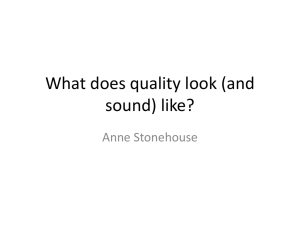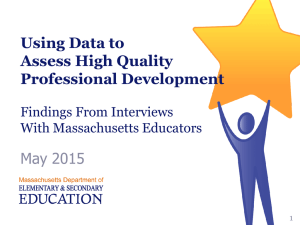The Massachusetts Standards for Professional Development
advertisement
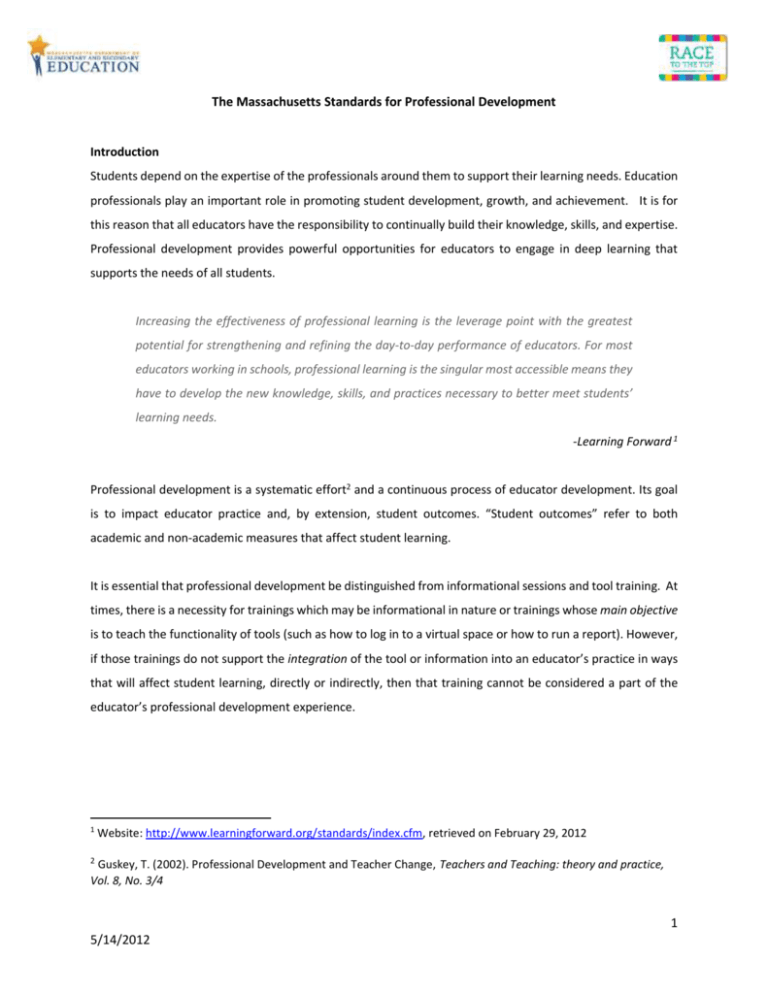
The Massachusetts Standards for Professional Development Introduction Students depend on the expertise of the professionals around them to support their learning needs. Education professionals play an important role in promoting student development, growth, and achievement. It is for this reason that all educators have the responsibility to continually build their knowledge, skills, and expertise. Professional development provides powerful opportunities for educators to engage in deep learning that supports the needs of all students. Increasing the effectiveness of professional learning is the leverage point with the greatest potential for strengthening and refining the day-to-day performance of educators. For most educators working in schools, professional learning is the singular most accessible means they have to develop the new knowledge, skills, and practices necessary to better meet students’ learning needs. -Learning Forward 1 Professional development is a systematic effort2 and a continuous process of educator development. Its goal is to impact educator practice and, by extension, student outcomes. “Student outcomes” refer to both academic and non-academic measures that affect student learning. It is essential that professional development be distinguished from informational sessions and tool training. At times, there is a necessity for trainings which may be informational in nature or trainings whose main objective is to teach the functionality of tools (such as how to log in to a virtual space or how to run a report). However, if those trainings do not support the integration of the tool or information into an educator’s practice in ways that will affect student learning, directly or indirectly, then that training cannot be considered a part of the educator’s professional development experience. 1 Website: http://www.learningforward.org/standards/index.cfm, retrieved on February 29, 2012 2 Guskey, T. (2002). Professional Development and Teacher Change, Teachers and Teaching: theory and practice, Vol. 8, No. 3/4 1 5/14/2012 Purpose and Audience The purpose of the Massachusetts Standards for Professional Development is to concretely describe, identify, and characterize what high quality learning experiences should look like for educators. The intent is to provide guidance on the preparation of High Quality Professional Development (HQPD) to any entity or person(s) responsible for facilitating, directly planning, or sponsoring professional development. In addition, it is crucial that educators, as consumers of professional development, are knowledgeable and cognizant of quality professional development. It is, after all, their experience and potential for improvement that is most impacted when professional development does not meet the threshold of excellence and quality. Who are Educators? We define “educators” as all professionals—teachers, administrators, specialists, and education support personnel—who have a direct or indirect impact on measures of academic and non-academic student outcomes. These educators are also identified by their eligibility for licenses from the Massachusetts Department of Elementary and Secondary Education3. What are the Standards? The Massachusetts Standards for Professional Development is Massachusetts’ definition of High Quality Professional Development. Educating all students well requires high-quality professional development experiences that embody specific attributes and respond to the needs of educators. Definition When we refer to High Quality in the context of professional development, we mean the careful consideration of how certain characteristics and attributes of a professional development experience will combine and interact to produce a set of desired student outcomes. As such, High Quality Professional Development is a set of coherent learning experiences that is systematic, purposeful, and structured over a sustained period of time with the goal of improving teacher practice and student outcomes. It enables educators to facilitate the learning of students by acquiring and applying knowledge, skills, and abilities that address student needs and improvement goals of the district, school, and individual. HQPD conforms to best practices in research and relates to educators’ assignments and professional responsibilities4. 3 Nonetheless, we encourage the use of the Massachusetts Standards for Professional Development for the planning of all professional development for any staff—those who require licenses and those who do not—whose work has an impact on student learning. 4 This definition was adapted from Kentucky’s State Department of Education. It was also informed by the work of the organization Learning Forward. 2 5/14/2012 We would like to acknowledge the inherent tension in trying to define professional development for such a broad audience. However, our task was to articulate the attributes of High Quality Professional Development that ALL entities responsible for providing, sponsoring, or planning professional development can follow. Districts can refer to the Massachusetts Conditions for School Effectiveness for additional guidance. Student Outcomes “Student outcomes” refer to two broad categories of student measures: Academic measures and NonAcademic measures. “Academic measures” refer to student learning, growth, and achievement. “NonAcademic measures” are indicators such as health, behavioral, or socio-emotional factors that support student learning. For additional information on non-academic measures, please refer to the Massachusetts Tiered System of Supports. Indicators of the Standards We anticipate that the Massachusetts Standards for Professional Development will guide programs of professional development and the individual courses or sessions that comprise a particular program. To support this goal, we have included indicators for each standard to further define the standard. Indicators will help in the planning, design, and delivery of professional learning experiences. Guiding Principles for High-Quality Professional Development (HQPD) The standards are held together by a set of guiding principles. The principles are the values and beliefs by which we operate and under which the standards were developed. Guiding Principle 1: HQPD is intentional Guiding Principle 2: HQPD is a process Guiding Principle 3: HQPD is evaluated for effectiveness Guiding Principle 4: HQPD requires strong leadership that: a. Strengthens the structure and organization of professional development b. Guarantees follow-up to professional development c. Promotes a culture of high expectations 3 5/14/2012 PROCESS STANDARDS PROCESS CONTENT STANDARDS THE MASSACHUSETTS STANDARDS FOR PROFESSIONAL DEVELOPMENT Standards Indicators 1. HQPD has clear goals and objectives relevant to desired student outcomes. 1.1 Professional development goals specify intended student outcomes. 1.2 Educator learning objectives specify changes in knowledge, skills, and practices necessary to achieve the intended student outcomes. 1.3 Learning objectives are written in SMART format. Specific &Strategic Measureable Action-Oriented Rigorous/Realistic/Results-focused Timed/Tracked 2. HQPD aligns with state, district, school, and/or educator goals or priorities. 2.1 Professional development goals align with educator performance standards, individual professional growth goals, and/or state, district, or school improvement priorities. 2.2 Professional development prepares educators to address state, district, school, and individual goals or priorities. 3. HQPD is designed based on the analysis of data relevant to the identified goals, objectives, and audience. 3.1 Student data from multiple sources inform decisions about professional development goals and learning objectives for the intended audience. 3.2 Educator data from multiple sources inform decisions about professional development goals and learning objectives for the intended audience. 4. HQPD is assessed to ensure that it is meeting the targeted goals and objectives. 4.1 Formative assessment using multiple sources of data measures progress toward professional development goals and learning objectives. 4.2 Summative evaluation measures the attainment of professional development goals and learning objectives. 4.3 Data from formative assessment and summative evaluations inform efforts to improve the quality and results of professional development. 5. HQPD promotes collaboration among educators to encourage sharing of ideas and working together to achieve the identified goals and objectives. 5.1 Professional development includes collaboration among educators to generate relevant, role-specific applications of their learning. 5.2 Skillful, prepared facilitators use protocols, processes, and strategies to facilitate collaboration during and after professional development to support implementation of learning. 6. HQPD advances an educator’s ability to apply learnings from the professional development to his or her particular content and/or context. 7. HQPD models good pedagogical practice and applies knowledge of adult learning theory to engage educators 6.1 Professional development includes multiple opportunities for educators to practice their learning and receive feedback. 6.2 Professional development supports educators to identify multiple applications of their learning within their everyday workplace responsibilities. 7.1 Professional development uses effective, research-based, adult learning strategies. 7.2 Professional development incorporates strategies for active engagement of learners. 7.3 Professional development facilitators model the practices needed to attain goals and learning objectives. 7.4 Professional development includes personalization and differentiation to meet unique learning needs of educators. 4 5/14/2012 CONTEXT STANDARDS 8. HQPD makes use of relevant resources to ensure that the identified goals and objectives are met. 8.1 Sufficient resources (time, funding, staff, materials, technology, etc.) are available to provide sustained support over time for full implementation of learning to attain goals and learning objectives. 8.2 Professional development resources are allocated equitably to address high-priority needs. 9. HQPD is taught or facilitated by a professional who is knowledgeable about the identified objectives 9.1 Skillful, prepared facilitators with content expertise lead professional development. 9.2 Facilitators of professional development seek and use feedback, coaching, and other supports to improve their knowledge, skills, and practice as leaders of learning. 10. HQPD sessions connect and build upon each other to provide a coherent and useful learning experience for educators. 10.1 Professional development incorporates strategies to connect new learning with learners’ past learning and experiences. 10.2 Individual professional development sessions or meetings link together in a logical and sequential manner to promote attainment of the goals and learning objectives. 5 5/14/2012 HOW DOES IT ALL WORK TOGETHER? Each one of the 10 standards may be considered to be part of the one or more of the guiding principles • P1: PD is intentional • P3: PD is evaluated for effectiveness • P2: PD is a process S1,2,3,10 S5,6,7,10 S3,4,6 S5,7,8,9 •P4: PD requires strong leadership that (a) strengthens the organization and structure of PD (b) guarantees follow-up and (c) promotes a culture of high expectations P - principle, S - standard 6 5/14/2012
